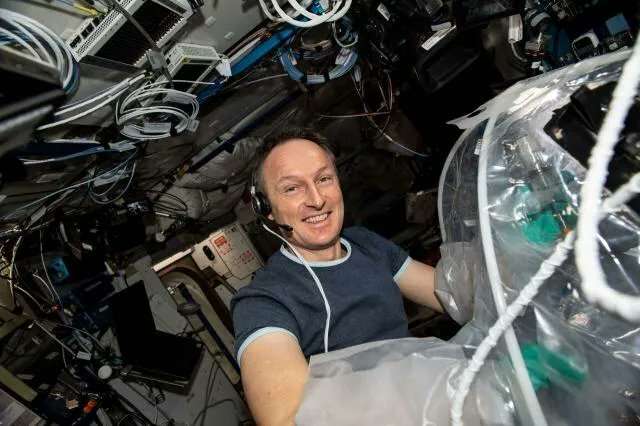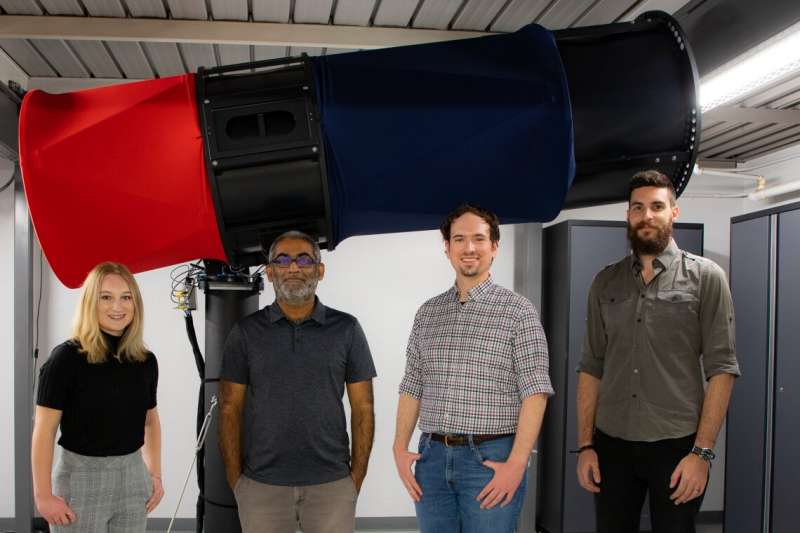How well does concrete work in space?
Wednesday, 16 February 2022 11:40
Concrete is not the first material one usually thinks of when exploring space. Nor is it the focus of much cutting-edge research. The most common building material has been used by humanity for thousands of years. But surprisingly, little is still known about some of its properties, due in no small part to the limitations of the environments it can be tested in. Now, this most ubiquitous of materials will be tested in a new environment—the microgravity aboard the International Space Station.
The experiment, part of the "Cosmic Kiss" mission, will have German astronaut Matthias Maurer hand-mixing concrete in microgravity using a specially designed mixer no larger than the size of his hand and a giant inflatable bag. That obviously will not lead to much concrete, but its properties will be particularly telling to scientists.
Students confirm errant rocket's Chinese origin, track lunar collision course
Wednesday, 16 February 2022 11:38
European Union advances broadband constellation despite negative assessments
Wednesday, 16 February 2022 10:52
The European Union is moving ahead with its proposed broadband constellation despite two negative internal assessments.
The post European Union advances broadband constellation despite negative assessments appeared first on SpaceNews.
Decisions from the 2022 Space Summit
Wednesday, 16 February 2022 08:51Press Release N° 4–2022
European leaders today confirmed their ambitious plans to work closely together to accelerate Europe as a world leader in space during a series of high-level meetings held in Toulouse, France.
End of Lockheed bid for Aerojet Rocketdyne may impact space, missile markets
Wednesday, 16 February 2022 04:20 Lockheed Martin, the largest U.S. defense contractor, has dropped its proposal to buy rocket-engine maker Aerojet Rocketdyne, but experts said another suitor could emerge.
The Sacramento-based Aerojet has produced engines for the space shuttle, is working on engines for NASA's next moon rockets and is also developing hypersonic missile systems for the U.S. military.
Lockheed said
Lockheed Martin, the largest U.S. defense contractor, has dropped its proposal to buy rocket-engine maker Aerojet Rocketdyne, but experts said another suitor could emerge.
The Sacramento-based Aerojet has produced engines for the space shuttle, is working on engines for NASA's next moon rockets and is also developing hypersonic missile systems for the U.S. military.
Lockheed said Orbex prepares for rocket launch 'dress rehearsals' as launchpad arrives at test site
Wednesday, 16 February 2022 04:20 The first rocket launchpad constructed in the UK for more than 50 years is now in place at the Orbex test site in Kinloss, Scotland.
The new launchpad - known as 'Orbex LP1' - recently completed an 80-mile road trip from Peterhead to Kinloss on two trucks, accompanied by a police escort. The three-hour journey through the dramatic Scottish countryside during sun, rain and snow was captured
The first rocket launchpad constructed in the UK for more than 50 years is now in place at the Orbex test site in Kinloss, Scotland.
The new launchpad - known as 'Orbex LP1' - recently completed an 80-mile road trip from Peterhead to Kinloss on two trucks, accompanied by a police escort. The three-hour journey through the dramatic Scottish countryside during sun, rain and snow was captured NASA offers up to $200M to help push new technologies to market
Wednesday, 16 February 2022 04:20 Companies with technologies that may advance exploration but need a little extra push to finalize development have two new opportunities to partner with NASA to make it over the finish line.
Through Tipping Point, NASA seeks to support space technologies that can foster the growth of commercial space capabilities and benefit future agency missions. NASA is also offering businesses a chance
Companies with technologies that may advance exploration but need a little extra push to finalize development have two new opportunities to partner with NASA to make it over the finish line.
Through Tipping Point, NASA seeks to support space technologies that can foster the growth of commercial space capabilities and benefit future agency missions. NASA is also offering businesses a chance China to make 6 human spaceflights, rocket's maiden flight in 2022: blue book
Wednesday, 16 February 2022 04:20 China will make six manned space flights in 2022 to complete the building of its space station and see the maiden flight of Long March-6A, the country's first carrier rocket powered by a solid and liquid engine.
Ma Tao, deputy director of the Space Department of the China Aerospace Science and Technology Corporation (CASC), revealed on Wednesday China's rocket launch plan at a press confer
China will make six manned space flights in 2022 to complete the building of its space station and see the maiden flight of Long March-6A, the country's first carrier rocket powered by a solid and liquid engine.
Ma Tao, deputy director of the Space Department of the China Aerospace Science and Technology Corporation (CASC), revealed on Wednesday China's rocket launch plan at a press confer Thousands of new astronomical images highlighted in latest release of AAS WorldWide Telescope
Wednesday, 16 February 2022 04:20 The American Astronomical Society (AAS) has launched WWT 2022, the latest version of AAS WorldWide Telescope (WWT), revealing new data and capabilities and providing an even more powerful astronomy visualization toolkit for astronomers, educators, and enthusiasts alike.
WWT isn't a physical telescope, but rather a suite of free and open-source software that integrates data and images from
The American Astronomical Society (AAS) has launched WWT 2022, the latest version of AAS WorldWide Telescope (WWT), revealing new data and capabilities and providing an even more powerful astronomy visualization toolkit for astronomers, educators, and enthusiasts alike.
WWT isn't a physical telescope, but rather a suite of free and open-source software that integrates data and images from UK candidates make it through to next round of European Space Agency's astronaut call
Wednesday, 16 February 2022 04:20 The window to apply for ESA's astronaut vacancy opened on 31 March 2021 and closed 18 June. This is the first call for new astronauts in over 10 years and the first-time candidates with a physical disability had been invited to apply.
Of the 22,523 valid astronaut applications received by ESA, 2,000 of these were from the UK.
Following a comprehensive screening phase, 1,361 people we
The window to apply for ESA's astronaut vacancy opened on 31 March 2021 and closed 18 June. This is the first call for new astronauts in over 10 years and the first-time candidates with a physical disability had been invited to apply.
Of the 22,523 valid astronaut applications received by ESA, 2,000 of these were from the UK.
Following a comprehensive screening phase, 1,361 people we China's moon sample updates lunar chronology model
Wednesday, 16 February 2022 04:20 Researchers led by Prof. YUE Zongyu and Prof. DI Kaichang from the Aerospace Information Research Institute (AIR) of the Chinese Academy of Sciences (CAS) and their collaborators have established an updated lunar chronology model that provides a more accurate timescale not just for lunar history but also for the evolution of planetary bodies in the inner solar system.
The research is based
Researchers led by Prof. YUE Zongyu and Prof. DI Kaichang from the Aerospace Information Research Institute (AIR) of the Chinese Academy of Sciences (CAS) and their collaborators have established an updated lunar chronology model that provides a more accurate timescale not just for lunar history but also for the evolution of planetary bodies in the inner solar system.
The research is based Final moments of planetary remnants seen for first time
Wednesday, 16 February 2022 04:20 The moment that debris from destroyed planets impacts the surface of a white dwarf star has been observed for the first time by astronomers at the University of Warwick.
They have used X-rays to detect the rocky and gaseous material left behind by a planetary system after its host star dies as it collides and is consumed within the surface of the star.
Published in the journal Nature
The moment that debris from destroyed planets impacts the surface of a white dwarf star has been observed for the first time by astronomers at the University of Warwick.
They have used X-rays to detect the rocky and gaseous material left behind by a planetary system after its host star dies as it collides and is consumed within the surface of the star.
Published in the journal Nature From matter to antimatter, to and fro - trillions of times a second
Wednesday, 16 February 2022 04:20 We think of matter and antimatter as being as opposite as fire and water. There are, however, particles that can behave as representatives once of the world of matter, once the world of antimatter. An international group of scientists working on experiments at the LHCb detector have reported their measurement of the extreme speed of oscillation of these sorts of particles between the two worlds.
We think of matter and antimatter as being as opposite as fire and water. There are, however, particles that can behave as representatives once of the world of matter, once the world of antimatter. An international group of scientists working on experiments at the LHCb detector have reported their measurement of the extreme speed of oscillation of these sorts of particles between the two worlds. Surprisingly high fraction of dead galaxies found in ancient galactic city
Wednesday, 16 February 2022 04:20 An international team of astronomers led by researchers at the University of California, Riverside, has discovered an unusual massive cluster of young galaxies forming in the early universe. The newly discovered growing galactic metropolis, named MAGAZ3NE J095924+022537, is a newborn galaxy cluster, or protocluster, consisting of at least 38 member galaxies, and is about 11.8 billion light-years
An international team of astronomers led by researchers at the University of California, Riverside, has discovered an unusual massive cluster of young galaxies forming in the early universe. The newly discovered growing galactic metropolis, named MAGAZ3NE J095924+022537, is a newborn galaxy cluster, or protocluster, consisting of at least 38 member galaxies, and is about 11.8 billion light-years Webb sees its first star - 18 times
Wednesday, 16 February 2022 04:20 The James Webb Space Telescope is nearing completion of the first phase of the months-long process of aligning the observatory's primary mirror using the Near Infrared Camera (NIRCam) instrument.
The team's challenge was twofold: confirm that NIRCam was ready to collect light from celestial objects, and then identify starlight from the same star in each of the 18 primary mirror segments. T
The James Webb Space Telescope is nearing completion of the first phase of the months-long process of aligning the observatory's primary mirror using the Near Infrared Camera (NIRCam) instrument.
The team's challenge was twofold: confirm that NIRCam was ready to collect light from celestial objects, and then identify starlight from the same star in each of the 18 primary mirror segments. T 
